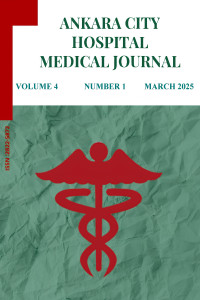The Importance of Etiological Cause in Patients Admitted to The Intensive Care Unit with Acute Respiratory Distress Syndrome
Abstract
There are many underlying etiologic causes in patients admitted to the emergency department with pulmonary edema and acute respiratory distress syndrome (ARDS).1 While the most common cause of pulmonary edema is cardiogenic problems, ARDS has non-cardiogenic pulmonary edema and viral and bacterial pulmonary infections are the most common causes of ARDS.2 Here, we report a case that illustrates the importance of identifying treatable underlying causes, including severe valvular disease and viral infection, in a patient presenting with ARDS.
A 47-year-old male was admitted to the emergency room with acute respiratory distress, chest pain, and mild confusion. On arrival, he was tachypneic (respiratory rate: 34/min), hypoxic (SpO₂: 82% on room air), tachycardic (HR: 110 bpm), and normotensive (BP: 130/85 mmHg). He rapidly deteriorated, necessitating intubation. The patient has no known diseases and no history of smoking, alcohol, or drug use. In his family history, his father only has primary hypertension. Initial laboratory and imaging studies revealed elevated acute-phase reactants (CRP: 185 mg/L, ferritin: 420 ng/mL), and chest X-ray showed bilateral ground-glass appearance, infiltrative findings and diffuse pulmonary edema. Arterial blood gas revealed a PaO₂/FiO₂ ratio < 100. APACHE II score on admission was 18.
The patient was hospitalized in the level 3 intensive care unit with a prediagnosis of viral pneumonia and ARDS. In the intensive care unit, the patient is placed in the prone position and given positive pressure ventilator support. Diuretic, broad-spectrum antibiotic and oseltamivir treatment was started. Deep tracheal aspirate culture was negative. Upon detection of Influenza A in the upper respiratory tract panel, antibiotic treatment was narrowed and the diagnosis of ARDS secondary to viral pneumonia was confirmed. Forty-eight hours after intubation, blood gases improved (PaO₂/FiO₂ > 250), and and extubation was performed at the 72nd hour with effective diuresis. At this stage, echocardiographic assessment demonstrated severe stenosis of both the aortic and mitral valves (mitral valve area: 0.9 cm², mean gradient: 14 mmHg; aortic valve area: 0.7 cm², mean gradient: 40 mmHg), for which the cardiology recommended valve replacement. The patient was admitted to the ward five days after intensive care and two weeks after the completion of infection treatment, the patient underwent aortic and mitral valve replacement by the cardiovascular surgeon. And our patient resumed his social life in a short time.This case underlines the complex interplay between infectious and structural cardiac causes in ARDS. While viral pneumonia (Influenza A) likely triggered the acute deterioration, underlying unrecognized valvular disease significantly contributed to pulmonary edema.3 In our case, both ARDS and pulmonary edema due to valvular heart pathologies were present and there were limitations in making an accurate definition. Although cardiovascular, atherosclerotic diseases, hypervolemia, renal failure or infectious agents are usually involved, it is necessary to determine the triggering factor correctly. Because if the triggering clinical picture is a correctable cause, we can prevent the patient from re-entering a mortal picture such as ARDS or pulmonary edema. As in our case, in a patient with aortic and mitral stenosis due to acute rheumatic fever, valve replacement can reduce the risk of sudden cardiac death and pulmonary edema.
Details
| Primary Language | English |
|---|---|
| Subjects | One Health |
| Journal Section | Letter To The Edıtor |
| Authors | |
| Publication Date | March 27, 2025 |
| Submission Date | March 21, 2025 |
| Acceptance Date | March 26, 2025 |
| Published in Issue | Year 2025 Volume: 4 Issue: 1 |


